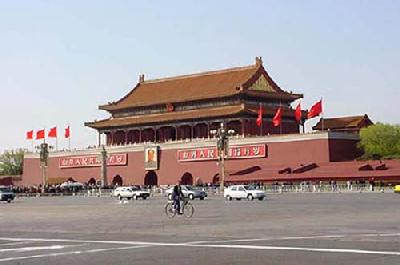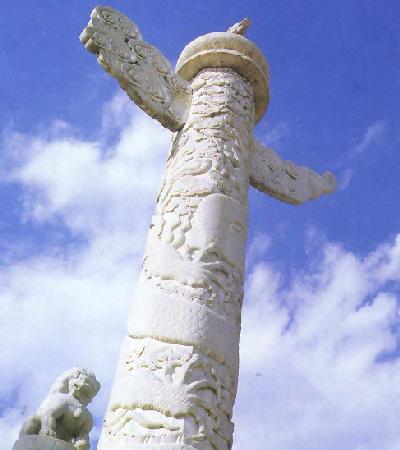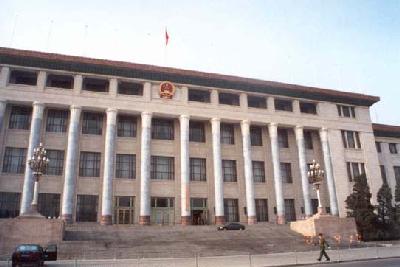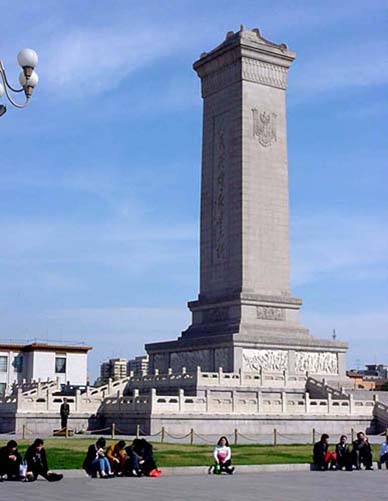 |
The grand Tian'anmen Gate (Heavenly Peace Gate) is a national symbol with the Great Hall of the People on the western side and the Museum of the Chinese Revolution and the Museum of Chinese History to its east and west.
The Monument to the People's Heroes -- the 36 meters high obelisk made of Qingdao granite, dominates the center of the square. The Chairman Mao Memorial Hall and the Qianmen gate, sit in the south.
 Tian'anmen Gate
Tian'anmen Gate
Tian'anmen Gate (Gate of Heavenly Peace) was built in the 15th century and restored in the 17th century. From imperial days, the yellow glaze-tiled double-eave tower functioned as a rostrum for proclaiming pronouncements to the assembled masses. On October 1, 1949, Chairman Mao Zedong proclaimed the founding of the new China here. The tower has five doors and in front of it are seven bridges spanning a stream. Only the emperor could use the central door and bridge. On the top of the central door is a gigantic portrait of Chairman Mao with slogans on each side saying 'Long Live the People's Republic of China' and 'Long Live the Unity of the Peoples of the World'. The gate leads to the imperial city -- the Forbidden City.
 |
 Hua Biao
Hua Biao
Right beside a pair of marble lions in front of the Tian'anmen Gate stand obelisk marble columns engraved with entwining dragons and clouds -- an ornamental architecture called Hua Biao. Its history can be traced back to the Yao and Shun, legendary kings in remote antiquity. It is said that, to improve the quality of governance, wooden crosses were erected at marketplaces for people to write down complaints. During the Han Dynasty (206 BC-220 AD), wooden posts were replaced by stone pillars, which gradually developed into the sumptuous columns that lead to palace gates. Hua Biao can usually be found in imperial gardens and mausoleums.
On top of the Hua Biao is a plate-like disc called Chenglupan (dew-collecting) on which squats an animal called Kong (a legendary animal for keeping guard) facing the south. They were called "Wangjungui" or "looking forward to the emperor's return", which watched over the emperor's excursions and called him back. The couple inside the gate facing north, called Wangjunchu or "looking forward to the emperor's progress", was considered to supervise the emperor's behavior in the court when he neglect court affairs.
 |
 Great Hall of the People
Great Hall of the People
West of the Square is the Great Hall of the People. This building, erected in 1959, is the site of the China National People's Congress meetings and provides an impressive site for other political and diplomatic activities. Twelve marble posts are in front of the Hall which has three parts -- the Central Hall, the Great Auditorium and a Banqueting Hall. The floor of the Central Hall is paved with marble and crystal lamps hang from the ceiling. The Great Auditorium behind the Central Hall seats 10,000. The Banqueting Hall is a huge hall with 5,000 seats.
 |
 Monument to the People's Heroes
Monument to the People's Heroes
The granite Monument to the People's Heroes is just at the center of the Tian'anmen Square, directly upon the central axis of the old city. The construction started in 1952 and was completed in 1958. The magnificent Monument is 37.94 meter in height and built with over 17,000 pieces of marble and granite. It is the largest monument in China's history. "The People's Heroes are Immortal" written by late-Chairman Mao is engraved on the monument. Two rows of white marble railings enclose the monument, simple and beautiful.
The base of the monument is decorated with eight unusually large relief sculptures. They depict chronological events during the revolutionary period from 1840 to 1949. The sequence begins on the eastern side and moves clockwise around the base. These are the events shown in the carvings:
On the eastern side we begin with destruction of Opium at Humen in Guangdong Province from 1839-1842. Next is the Jintian Uprising in Taiping Heavenly Kingdom in Guangxi from 1851-1864. On the next side facing south we see the 1911 Revolution in Hubei Province, the May 4th Movement in Beijing in 1919 and the May 30th Movement in Shanghai in 1925. To the west the pictures are the Nanchang Uprising in Jiangxi in 1927 and the War of Resistance against Japan from 1937-1945. On the last side we see Grain for the Front; the Successful Crossing of the Yangtze River in 1949 and, last but not least, a picture entitled "Long live the Liberation Army!"
 China National Museum
China National Museum
Another important place for tourists to visit is the China National Museum at the east side of the Square. It just came into existence in 2003 and is a combination of Chinese History Museum and Chinese Revolutionary Museum. This National Museum faces the Great Hall of the People. Inside the Chinese Revolutionary Museum are a lot of material objects, pictures, books and models to present the development of modern China. The Chinese History Museum shows a large number of cultural relics illustrating the long history and glorious culture of China from 1,700,000 years ago to 1921 when the last emperor left the throne.
 Mao Zedong Memorial Hall
Mao Zedong Memorial Hall
Located at the southern end of Tian'anmen Square just behind the Monument to the Heroes of the People is the hall where the remains of Chairman Mao are kept. Many Chinese show deep respect when confronted with the physical presence of Mao.
It is a relatively new structure. Construction began in 1976 after the death of our leader Mao Zedong and completed only a year later in 1977. Chairman Mao was born on December 26, 1893, in Hunan Province. He passed away in Beijing on September 9, 1976, at the age of 83.
The hall is 260 meters long from north to south, 220 meters wide from east to west and 33.6 meters high. Like the Monument to the Heroes of the People, it is also located on the central axis of old Beijing. It has five parts, namely, the Courtyard, the Memorial Hall, the North Hall, the Viewing Hall and the South Hall.
In the Viewing Hall, the remains of Chairman Mao are displayed in a crystal casket. The casket is mechanically raised from a freezer for viewing during the day and then lowered again at night. It can be viewed on most mornings.